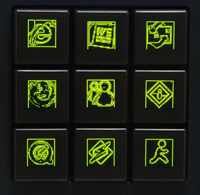Usage and Conclusion
Having used the OCZ Sabre OLED keyboard for a couple of weeks on my main system, I ended up having mixed opinions. The standard 103-keyboard works just fine. I would have preferred a larger, more pronounced wrist rest, but other than that it gets the job done.
General typing and button pressing takes a hair more force than I am used to with my Logitech G15. This could easily be accredited to the fact that it is brand new and I have owned the G15 for a few years, so odds are the keys will loosen a touch over time. I also noticed the keys are a bit more audible than the G15. The Sabre keys are clickier and have a slight thud as each key is depressed whereas the G15 seems to have a slightly lighter overall tone. Even so, the Sabre is nowhere near as loud as say, the Das Keyboard.
Overall build quality on the main keys is sturdy. There is very little wiggle room when moving a finger back and forth across a single key without pressing it. This is not the case on the G15 where I find a lot of horizontal play in each key.

The top of the OLED keys are flat unlike the slight concave typing keys. Since these keys are so large, it seems natural to want to press them in the center, although I had no trouble activating them by pressing anywhere on the key. Unlike the typing keys, however, the OLED keys weren't as rigid and did have a good bit of play in them.
Besides the OLED key bank, there are no other additional features like USB ports or media controls to draw you in. The blue LEDs on either side of the board didn't seem to offer much functionality in a real usage scenario as they were not bright enough to overcome the illumination from my monitors.
Anyone interested in this keyboard is clearly in it for the OLED keys. My everyday keyboard is a Logitech G15 which has a bank of macro keys that I have come to love. Coming from that background the OLED keys on the Sabre provided me with a ton of functionality. Having one stroke shortcuts to frequently opened programs and text strings that I type often like my email address and passwords is a huge time-saver.
The main issue I have with the Logitech G15 is forgetting which programmed key performs which function. The Sabre eliminates this guesswork, allowing you to display a helpful visual reminder of exactly what each key does. This can go a long way in games and virtually any application where you can program macros and have icons to remind you what each button does.
The nine OLED key limitation is easily overcome thanks to the included management software that can recognize and switch control layers based on the active program or application at any given time.
As cool as the OLED keys are, the fact that they are monochromatic can be problematic at times. The pre-loaded images look great, as they were designed for use on the yellow OLED screens. The result was lackluster however when loading icons or graphics that weren't designed specifically for monochromatic use. Images with multiple colors simply looked bad when loaded onto the Sabre. For example, when you bind a button to launch an application, the management program asks if you want to load an icon from the program's icon set. Almost all of the icons I tried had random dots lining the border which looked terrible.


I tried changing the rendering option from dither to contour which didn't seem to help matters as you can see in the example photos. I was, however, able to find several usable graphics via Google's image search. The key was to look for images with a solid black background and minimal color changes. You could just as easily create your own icons if you are somewhat versed in graphic design. Unfortunately I am not.
I checked OCZ's support forums in hopes of finding some additional downloadable graphics to use but came up empty handed. I could see a user-created graphics gallery being a great resource for fellow Sabre owners.


Aside from this, I had no other issues with the OLED keys. They worked every time, the layer images and functions changed instantly as I focused on different programs and the keys were nice and bright and easily viewable from almost any angle.
The OCZ Sabre Keyboard can be found for around $145 at various online retailers. That means you are still paying a premium versus a standard keyboard, but as things stand today the Sabre remains a very unique product. If you don't mind so much about looks as you do about functionality, the Sabre is an excellent and affordable alternative to a full-color OLED keyboard.
Pros: Nine programmable OLED keys. Infinite number of layers. OLEDs use little power. 128 MB on-board memory. Affordable compared to other OLED offerings.
Cons: Monochromatic keys severely limit image usability - Aren't overly pretty. No Extras (USB Ports, Media Controls, etc.). Sidelighting is no more than a gimmick.
